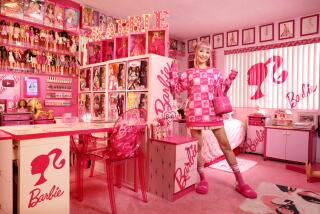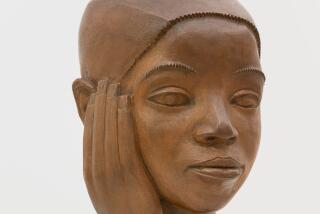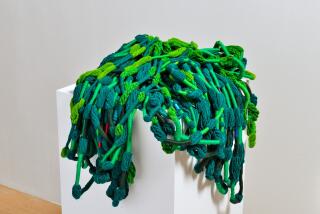N.Y. Folk Art Museum Gets All Dolled Up
- Share via
Maybe it’s the cult of personal decorating, but dolls seem to have the run of the house rather than being banished to the kids’ rooms.
It could also be that collectible dolls are more an object of art than for a child’s amusement.
“I enjoy my dolls more than my children ever did,” said Akira Blount, an artist from Bybee, Tenn.
Blount made her first doll 27 years ago, before the birth of her first child. Her dolls and those by a number of other artists are on exhibit at the Museum of American Folk Art in New York through Sept. 8.
“This is one of the first exhibitions of dolls at a general museum,” said Krystyna Poray Goddu. Goddu is co-curator and co-author with Wendy Lavitt of “The Doll by Contemporary Artists,” (Abbeville Press, $45), a primer on artist-made dolls.
While the number of adults who collect dolls is unknown, Goddu says there are three national magazines on the topic with a total circulation of more than 200,000, including Dolls, a magazine Goddu helped found in 1982.
Adult interest in dolls began to rise in the early 1980s as the number of artists and craftsmen making dolls increased.
For serious collectors, the most desirable dolls are antiques, one-of-a-kind dolls made by contemporary artists and limited editions. Also desirable are dolls mass-produced in the 1940s, ‘50s and ‘60s, the golden age of doll-making with its early Barbies and Madame Alexander and Betsy McCall dolls.
Typically the collector is a woman who is interested in period fashion and history. Or she may have started a collection by buying the dolls she wanted as a child but her family could ill afford.
Collectors go to great lengths to create a fitting environment for their dolls, so it’s not uncommon for dealers to make house calls. For one recent client, Karen Shay and Barb Lovett, of A Victorian Doll Shoppe in Northville, Mich., set up a showcase of dolls and accessories such as a crystal lamp, candlesticks, an antique purse and pearls spilling out of a box.
Collectors also look to magazines for display ideas, according to Goddu, now special projects editor at Dolls. In the June-July issues, both Dolls and Contemporary Doll Collector magazines feature articles on displaying dolls in the home.
“Some people buy an old wicker bassinet or a crib and fill it with dolls,” Goddu said. “Others arrange dolls around a child-size table set for tea, or in a highchair in a dining room.”
They also can be displayed on long shelves or on perches large enough for one or two. Lights under glass, such as in a large curio cabinet or a commercial display case, also are used. Those with unusually large collections may devote an entire room to a personal museum.
“Owl Deva,” by Akira Blount, is among dolls at the Museum of American Folk Art. The 22-inch female figure wears an owl mask and sits in a twig chair made by her the artist’s, Larry Blount. The doll holds a nest with eggs in it.
“A deva is a creative and protective spirit, and the doll is protecting the eggs,” Akira Blount said. “On a symbolic level, the doll is about protecting species to make sure they survive. But on a simpler basis, I love animals and often incorporate then into my dolls.”
The Blounts have built other vignettes to sell, and an Atlanta decorator recently chose a Blount doll as the main decorative element in the foyer of her home.
Dolls are also going to business. A 4-foot vignette created by the Blounts is a permanent installation in the lobby of North Point Center East, an office building in downtown Atlanta.
“The fact that dolls are being used as art installations and as home accessories tells me that the attitude that dolls are just toys has really changed,” Akira Blount said.
More to Read
The biggest entertainment stories
Get our big stories about Hollywood, film, television, music, arts, culture and more right in your inbox as soon as they publish.
You may occasionally receive promotional content from the Los Angeles Times.










